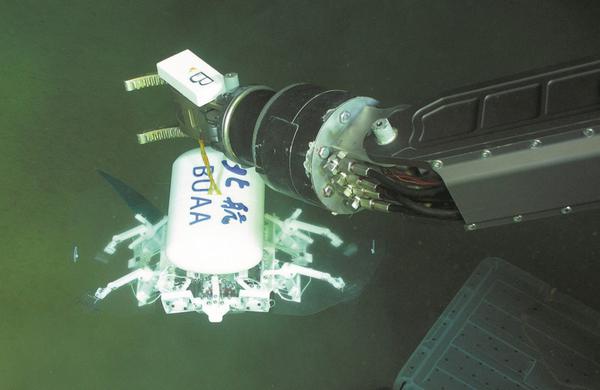
A deep-sea robot is released onto the seafloor of the Mariana Trench, reaching a depth of 10,666 meters. (Photo provided to China Daily)
A team of Chinese scientists has developed a miniature 2.7-kilogram deep-sea robot to explore the deepest natural frontier on Earth — the Mariana Trench in the western Pacific Ocean, according to a study published in the journal Science Robotics in March.
The researchers from Beihang University, formerly known as the Beijing University of Aeronautics and Astronautics, have further consolidated China's position as one of the few nations able to explore the deepest depths of the oceans.
Headed by Professor Wen Li, researchers from the university's School of Mechanical Engineering and Automation started working on the robot's design in 2019 and completed its construction in 2021. So far, the team has collaborated with peers from the Chinese Academy of Sciences' Institute of Deep-sea Science and Engineering and Zhejiang University to use the 50-centimeter-long machine for deep-sea exploration.
Zuo Zonghao, a doctoral student at the school and a member of Wen's team, said that the overall goal of the project was to build a robot to demonstrate new actuator technologies and to verify a new configuration of deep-sea probes.
"The core part of our robot is a centimeter-scale deep-sea soft actuator that weighs 16 grams. It incorporates bistable chiral metamaterials and tube-sealed shape-memory alloys," he said.
These actuators and materials mean that the robot is able to move its fins, flex and swim, as well as glide and crawl on the surface of the seafloor.
The robot has already been used by two of China's most advanced crewed submersibles — Shenhai Yongshi, or Deep-sea Warrior, and Fendouzhe, or Striver, and has carried out 14 seabed trips to assess its capabilities and performance.
"Under the sea, it is powered by a special lithium battery and is released and retrieved by the submersibles' robotic arms. During each operation, it worked for more than 20 minutes," Zuo said.
"During one of the operations that took place in 2021, it was released by Fendouzhe onto the seafloor of the Mariana Trench, reaching a depth of 10,666 meters."
During the next phase, researchers will mount buoyancy and scientific devices such as special cameras and sensors on the robot, and they plan to build a larger prototype, he said.
Such robots can be used in marine resource development, archaeological excavation and environmental monitoring in the future, Zuo added.


















































 京公網(wǎng)安備 11010202009201號
京公網(wǎng)安備 11010202009201號